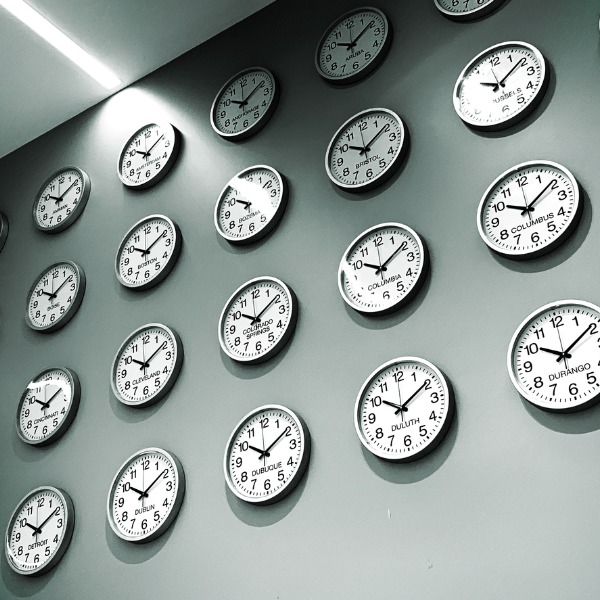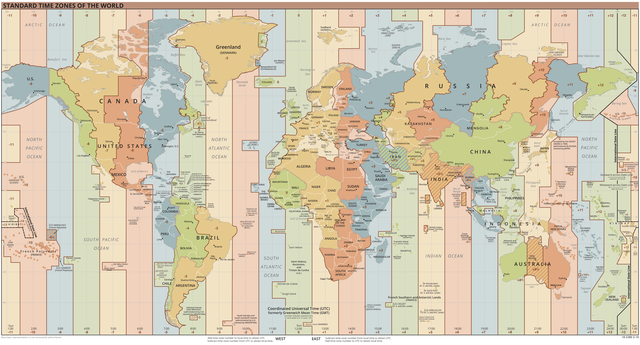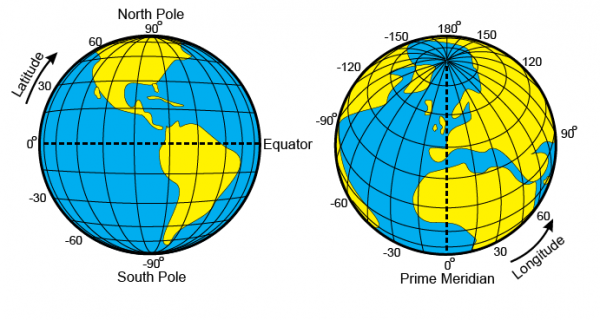Universal Coordinated Time

Wall of clocks (KevinKlimaPhoto, iStockphoto)

Wall of clocks (KevinKlimaPhoto, iStockphoto)
Today, you know it's the same time everywhere in your time zone thanks to Universal Coordinated Time. But when humans used the Sun to tell time, they couldn’t tell time precisely.
The concept of time is universal among humans. But telling time precisely has not always been important. Traditionally, humans have used the movement of the Sun through the sky to tell time. Some humans have simply observed the movement of the Sun. Others have used devices such as sundials and time sticks. To tell time more precisely for short periods, humans also used devices such as hourglasses, candle clocks, and water clocks.
In the past, different towns had their own official times. Every town’s clock would tell the town’s official time. That town clock would be synchronized with the position of the Sun. But when railroads and steamships became common in the 19th century, it became very important to have a commonly agreed-upon time in different places. That way, the arrivals and departures could of ships and trains could be properly scheduled.
In Britain, the country’s clocks were all synchronized to Greenwich Mean Time (GMT). That is the time in the borough of Greenwich in London, U.K.. Greenwich is at zero degrees longitude. It is also the place where the Royal Observatory, Britain’s first publicly-funded scientific institution, is located. A telegraph or radio at the official clock in GMT would send out a signal every hour so that other clocks could be set to match the official clock. Following England’s lead, other countries also began setting up standardized local times. This created time zones. Sunrise and sunset happen at approximately the same local time for everybody living in a time zone. By 1883, Canada and the United States had adopted a standard time system using five time zones, much like the ones we use today.

Coordinated Universal Time (UTC) is the system that people now use to keep time. UTC is also called Zulu Time by people who work in the military or in aviation.
UTC combined time zones to divide the world into twenty-four vertical sections along lines of longitude. Lines of longitude measure how far you are east or west of the Prime Meridian, which is at 0 degrees longitude. Time zones are more or less equal in size. They’re designed to allow for sunrise and sunset to happen at approximately the same local time at a given latitude, no matter where in the world you are. Lines of latitude measure how far north or south of the Equator you are.
Did you know?
Astronauts in space use UTC to tell time on board their spacecraft.

You can calculate local time anywhere on Earth if you know what the UTC is and what your local time zone offset is. Your local time zone offset is the difference between your time zone and UTC (which happens to be the same time as GMT). For instance, let’s say you are in the Eastern Standard Time zone, which is five hours behind UTC. (UTC -5) If UTC is 11:00, then your local time is 06:00 (11 – 5 = 6). You can also use online tools such as the Time Zone Converter to figure out what your local time is compared to UTC.
Many parts of Canada use the 12-hour clock. The 12-hour clock starts at 12:00AM (midnight) and goes until 11:59 AM. Then it starts again at 12:00PM (noon) and goes until 11:59PM. But most of the world, including the world’s space organizations, also use what is known as a 24-hour clock to tell time. This is sometimes called “Military Time.” It’s used to reduce the chances of mistakes in time if AM or PM are accidentally mixed up, or not written in the first place. The 24-hour clock starts at 00:00 (midnight) and goes to 23:59 every day. The time is sometimes written without a colon between the hours and minutes, which would look like this: 2359.
Did you know?
French Canada uses the 24-hour clock.
To convert from the 12-hour clock to the 24-hour clock, simply add 12 to the hours if the time is in the afternoon or evening (PM). For instance, 3:00PM in the 12-hour clock system would be 15:00 in the 24-hour clock system.
Did you know?
In 1879, Canadian engineer and inventor Sandford Fleming proposed the concepts of worldwide standard time and the 24-hour clock.
Computers also use a 24-hour clock that includes seconds and milliseconds (thousandths of a second). Let’s imagine it’s 5:36 PM on October 4, 2018. A date-time stamp on computer data might look like this:
2018-10-04T17:36:00.00Z
The date comes first [2018 (year) - 10 (month - October) - 04 (day)].
The specific time comes next beginning with a T which stands for time: [T (time) 17 (hour,17 or 5PM): 36 (minutes) : 00.00 (seconds and milliseconds)].
Finally, the time ends with a “Z” which stands for Zulu Time or UTC.
References
Creet, M. (1990). Sandford Fleming and universal time. Scientia Canadensis, 14(1-2), 66-89. DOI: 10.7202/800302ar
International Organization for Standardization. (2018). ISO 8601 Date and time format.